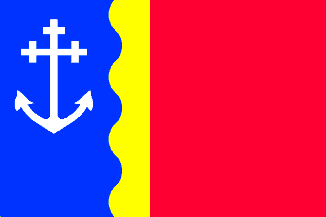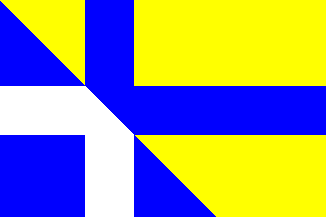 Shipmate Flagchart : http://www.flagchart.net
Shipmate Flagchart : http://www.flagchart.net
adopted 1991

Last modified: 2018-12-15 by rob raeside
Keywords: maasbracht |
Links: FOTW homepage |
search |
disclaimer and copyright |
write us |
mirrors
 Shipmate Flagchart : http://www.flagchart.net
Shipmate Flagchart : http://www.flagchart.net
adopted 1991
The anchor on the flag symbolizes the river-function of the municipality.
The three crosses on the anchor symbolize the three
municipalities added (I think)
Jarig Bakker, 9 December 1999
![[Maasbracht Coat of Arms]](../images/n/nl-li)mb.jpg) image from this
webpage.
image from this
webpage.
Granted 1991.
![[Maasbracht old flag]](../images/n/nl-li_mb.gif) by Jarig Bakker, 7 Apr 2005
by Jarig Bakker, 7 Apr 2005
Maasbracht old municipal flag
adopted 6 Sep 1966; design: Hoge Raad van Adel.
Description: Square, in red a white saltire, with four yellow crosses
crosslet. The arms of c. 1/10 flagheight.
It is derived from the (heraldic) right part of the municipal arms,
which shows the arms of the court of aldermen of Echt.
Source: Vexilla Nostra 18 (126), p. 43.
Jarig Bakker, 7 Apr 2005
The crosses should be blazoned "four yellow crosses crosslet".
I don't know if "cross" has a diminutive, if you're trying to use "crosslet"
that way. (A field semée of crosses is also called "crusilly"...).
Lewis A. Nowitz, 7 Apr 2005
You're right. "Cross crosslet" means a cross with small crosses at the
ends of each arm.
The flag shown is actually quite similar to the arms of a prominent
English noble house from the time of the Wars of the Roses - Beauchamp
(gules a fess or between six crosses crosslet of the second). Anne, heiress
of the Beauchamps, was the wife of Richard Neville, Earl of Warwick (a.k.a.
"The Kingmaker").
James Dignan, 7 Apr 2005
I checked it on Ralf Hartemink's
site, where he writes:
"Echt (Limburg province) is known since
the 7th century. It was named as a grant by Peppijn van Herstal. At first
the village belonged to the County of Loon (now Limburg), but in the 13th
century it was moved to Gelre (Gelderland). In 1267 it definitively belonged
to Gelre. The village received city-rights in the 14th century, date unknown.
It is listed as one of the cities of the Overkwartier of Gelre in 1343
(that is: the quarter on the other side of the Rhine.)
The seal of the Council of Aldermen was first mentioned in 1259; the
oldest preserved specimen was fixed to a deed of 12 Dec 1277. It was last
encountered fixed to a deed dated 19 Feb 1794.
The origin of the seal is unknown.
It is interesting that several British families used the same cross
crosslets (at least that's what I understand from Fox-Davies paperback).
-- Jarig Bakker, 7 Apr 2005
 Shipmate Flagchart : http://www.flagchart.net
Shipmate Flagchart : http://www.flagchart.net